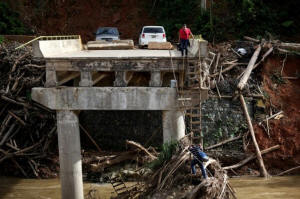|
Puerto Rico's death toll from Hurricane
Maria raised to nearly 3,000
 Send a link to a friend
Send a link to a friend
[August 29, 2018]
By Steve Gorman
(Reuters) - Puerto Rico's official death
toll from Hurricane Maria, the most powerful storm to hit the Caribbean
island in almost a century, was raised on Tuesday from 64, a number
widely discounted as far too low, to nearly 3,000, based on a study
ordered by the governor of the U.S. territory.
The report found that an estimated 2,975 deaths could be attributed
directly or indirectly to Maria from the time it struck in September
2017 to mid-February of this year.
By comparison, deaths blamed on Hurricane Katrina in 2005 range from
about 1,200 to more than 1,800, most along the Gulf Coast of Louisiana
and Mississippi.
The latest Puerto Rico figure was derived from comparisons between
predicted mortality under normal circumstances and deaths documented
after the storm, a number that turned out to be 22 percent higher.
(Study on Hurricane Maria: https://bit.ly/2wwqEqF)
Researchers said they adjusted for various factors that could account
for fluctuations in mortality, most notably the displacement of some
241,000 residents who fled the island in the immediate aftermath of the
storm.
They also found that the poor and elderly were disproportionately hard
hit in terms of risk of fatalities.
The emergency response to Maria became highly politicized as the Trump
administration was castigated as being slow to recognize the gravity of
the devastation and too sluggish in providing disaster relief to Puerto
Rico, an island of more than 3 million residents.
POLITICIZED DISASTER
The storm made landfall with winds close to 150 miles per hour (241 km
per hour) on Sept. 17 and plowed a path of destruction across the
island, causing property damage estimated at $90 billion and leaving
much of the island without electricity for months.
It was the third major hurricane to hit the United States with lethal
force in less than a month last year, following Harvey in Texas and Irma
in the Caribbean and Florida.
The disconnect between the administration's initial sanguine assessment
of the situation and the enormity of the disaster was evident 12 days
into the crisis when Elaine Duke, then acting U.S. homeland security
secretary, characterized the federal response as "a really good news
story" and spoke of a "limited number of deaths."
In a scathing reaction, San Juan Mayor Carmen Yulin Cruz appeared on CNN
declaring, "Damn it, this is not a good news story. This is a
people-are-dying story. This is a life-or-death story."
In early October 2017, Trump expressed satisfaction with the federal
response to Maria, saying it compared favorably with a "real catastrophe
like Katrina."
The storm's death toll has remained controversial as unofficial
inquiries and independent research suggested the loss of life was far
higher than 64 people formally counted as having perished.
Tuesday's study, conducted by George Washington University's Milken
Institute School of Public Health and released on Tuesday, was billed as
the most comprehensive yet.
[to top of second column]
|

A woman looks as her husband climbs down a ladder at a partially
destroyed bridge, after Hurricane Maria hit the area in September,
in Utuado, Puerto Rico, November 9, 2017. REUTERS/Alvin Baez/File
Photo

White House press secretary Sarah Sanders said the administration
supported "efforts to ensure a full accountability and transparency
of fatalities" from the hurricane.
But U.S. Representative Nydia Velazquez, a New York Democrat, said
the study was "only the latest to underscore that the federal
response to the hurricanes was disastrously inadequate, and as a
result, thousands of our fellow American citizens lost their lives."
The second phase of the study will examine causes and contributing
factors behind the deaths, said Carlos Santos-Burgoa, a professor of
global health who was the lead investigator of the study.
Santos-Burgoa said the high death toll, ranking Maria among the
worst natural disasters in U.S. history, was evidence that "we lack
a culture of preparedness." He said financial instability and a
fragile infrastructure made Puerto Rico especially vulnerable to
such calamities.
The report was conducted in collaboration with the University of
Puerto Rico Graduate School of Public Health and commissioned by
Puerto Rico Governor Ricardo Rossello.
Speaking at a news conference in Puerto Rico's capital, San Juan,
Rossello said his government was adopting the findings as the
official account of human life lost in the disaster, "even though it
is an estimate."
"We will take the 2,975 number as the official estimate for the
excess deaths as a product of the hurricane," he said.
Researchers attributed undercounting of storm-related deaths to poor
communications and the lack of well-established guidelines and
training for physicians on how to certify deaths in major disasters.
In May a Harvard University-led research team estimated that 4,645
lives were lost from Maria on Puerto Rico. A Pennsylvania State
University study put the number at 1,085..
Santos-Burgoa said his group's analysis factored in greater
historical data and more statistical variables.
(Reporting by Steve Gorman in Los Angeles; Additional reporting by
Gabriella Borter in New York and Karen Pierog Chicago; Editing by
Leslie Adler and Lisa Shumaker)
[© 2018 Thomson Reuters. All rights
reserved.]
Copyright 2018 Reuters. All rights reserved. This material may not be published,
broadcast, rewritten or redistributed.
Thompson Reuters is solely responsible for this content. |